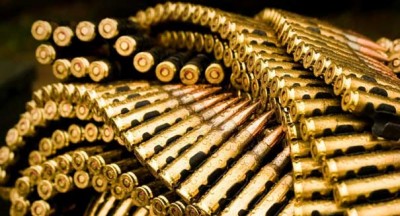 Being ready for an emergency situation that could make living in the wilderness a necessity for you and your family involves a lot of time and planning. It also involves a lot of preparation so that you’re family is able to make an assortment of homemade items that are used every day but that might not be available during an emergency.
Being ready for an emergency situation that could make living in the wilderness a necessity for you and your family involves a lot of time and planning. It also involves a lot of preparation so that you’re family is able to make an assortment of homemade items that are used every day but that might not be available during an emergency.
If you have a few guns in your emergency store, you probably also have a stock of bullets. If you need to survive in the wilderness for a long time however, that stock of bullets might eventually run out. What then? A valuable skill for any survivalist who knows their way around a gun is making homemade ammo. If you want to try your hand at loading your rifle or shotgun with homemade bullets or shells, you’re going to need some specific materials and supplies.
Safety Gear
Before you ever get to the fun stuff, you need to make sure that you have some standard safety equipment. After all, you are going to be working with liquid metal and hot stoves, so take all the necessary precautions to prevent burns and other injuries. First, you will need a pair of safety glasses or goggles in case of splashing. If you’re melting a large amount of metal for your bullets, you want to make sure it doesn’t get anywhere near your eyes or face. Also wear heavy gloves, because again, you’re going to be working with very hot materials that will leave pretty nasty scars if they ever touch your bare skin. Save your hands and wear leather gloves. The last of the standard safety materials is close-toed shoes. This is pretty self-explanatory. If you don’t want hot liquid metal on your hands, you also don’t want it on your feet. Other safety precautions besides wearing sturdy gloves and eyewear would be melting the metal in a well-ventilated area and always having a solid surface to work on.
Metal
The traditional metal for making bullets is lead, but lead is too soft for modern handguns and rifles, so you are going to have to mix it with a little bit of tin to make it harder and easier to work with. There are a few different kinds of places where you can get your metal so that you don’t pay an arm and a leg for it. Another reason people often make their own ammunition is because it’s much cheaper than buying new rounds, so shop around until you find the best place to buy from.
Ultra-Efficient Water Filter Fits In Your Pocket!
Often, scrap yards and plumbing supply shops will sell lead, and you can also look for mail-order companies or companies online that sell ammo-making supplies. The best place to find all your metal in one place though, is at auto and tire shops. Used wheel weights are made entirely from lead, tin, and antimony, which makes the bullets even harder and more durable. They are basically pre-mixed bullets that haven’t been melted down yet. The best part is that a lot of these shops will give them to you for free and let you have as much as you can carry.
Melting Pot
If you really want to, you can go all cowboy and melt the lead alloy over a campfire with an old iron pot and a ladle. On the other hand, you can also use an aluminum saucepan and a single electric burner. The single electric burner is better than using the saucepan on the stove because your kitchen doesn’t necessarily have the best ventilation. If you have a garage or even a deck, you should melt the metal there, since the mixture of metal and wax used to purify the metal smokes quite a bit. Along with the melting pot, it’s a good idea to have several stainless-steel condiment cups. They look like very small buckets, and they’re used to make the lead alloy ingots that will then be used to make bullets.
Flux

.
Fluxing the bullet metal is an important process is producing high-quality bullets. Flux is the name of the wax or bullet lube that is dropped into melted metal to get out any impurities and other junk floating around. Wheel weights are made of lead, tin, and antimony, but some other compounds get stuck to them as well. Dropping in a few shavings of wax or bullet lube purifies the lead alloy, because anything that isn’t lead alloy will stick to the fluxing compound. It acts like a magnet for all impurities and flecks of metal that aren’t lead, tin, or antimony. You stir the fluxing compound into the melted alloy and then scoop it of the top after everything has been picked up.
Bullet Molds
Bullet molds come in all shapes, sizes, and models. You need a different mold for every caliber, weight, and style of bullet you want to make. These you will need to buy through a company that makes bullet making tools, and you can usually buy them online. You can find used molds on eBay that will be a little cheaper, but if you intend to use the molds frequently, it’s best to get a new one.
The Process of Bullet Making
Once you have everything you need to make bullets, it’s time to start the process. First, you need to set up your station outside or in your garage. Make sure the area is well lit and ventilated. Start by melting several pounds of wheel weights in the aluminum pot on the electric burner. Once it’s melted, you will start the fluxing process by dropping in the wax shavings or bullet lube. Stir it into the melted alloy and wait for it to collect the impurities and steel shavings. The wax and lube might cause the melted metal to start smoking or maybe even burning. This is okay; just wait for the smoking to stop before you scoop all the stuff off of the top. Use another small steel pan to dump the skimmed impurities into.
Once you have a nice silvery-looking pot of melted lead alloy, it’s time to pour it into the stainless steel condiment cups to make ingots. Set the cups on a baking tray so that they have a good flat surface. You can also put the baking tray on the ground for added stability. Take the pot and slowly pour the melted alloy into the condiment cups until you fill them a little over halfway. When you’re done pouring, let the condiment cups full of alloy solidify. After about ten minutes, use your leather gloves to turn the condiment cups upside-down so that the newly formed ingot will fall out. They should pop out without difficulty, but if you need to, just give the bottom of the cup a little smack.
Now you have a perfectly formed ingot that you can reheat and pour into a bullet mold. To make the actual bullets, reheat the ingots one or two at a time and follow the instructions on your bullet mold. Some will tell you to lube up parts of the mold to help the bullets settle better or form better. After you’ve done this, use a small iron ladle to pour the melted alloy into the bullet mold until a small puddle forms on top of the mold. Wait a few seconds, and then open the mold to shake the bullets out. During this process, it’s important to wear your safety goggles and gloves to avoid spilling the melted metal on your hands since most bullet molds are handheld.
Don’t forget, making bullets and other types of ammo requires a strong knowledge of gunmanship and common sense. Working with any type of firearm is dangerous, and safety precautions should always be taken so that you and others aren’t harmed. If possible, never keep a loaded gun in your house without at least having the safety on and making sure that it’s properly stored away from children and others who could harm themselves with a loaded weapon.
 Off The Grid News Better Ideas For Off The Grid Living
Off The Grid News Better Ideas For Off The Grid Living



